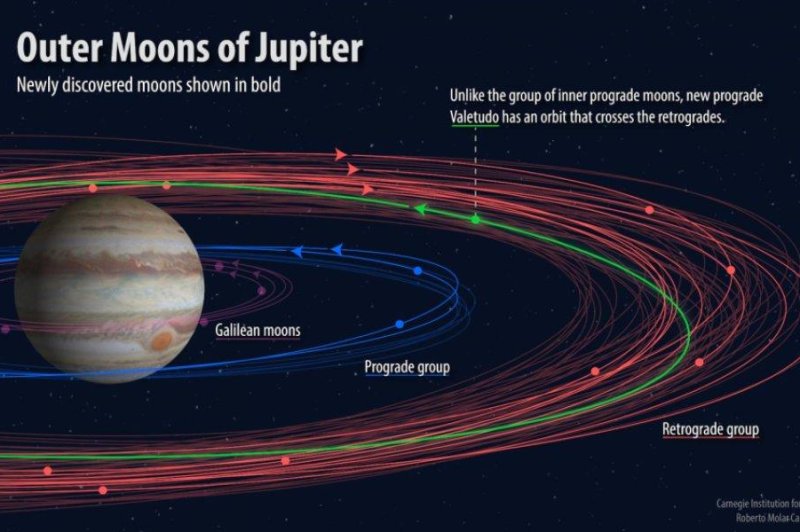The oddball prograde moon crosses the paths of Jupiter's outer groups of retrograde moons. Photo by Roberto Molar-Candanosa/Carnegie Institution for Science
July 17 (UPI) -- Astronomers have discovered 12 new moons circling Jupiter. With a total of 79 moons, Jupiter is now the most lunar-rich planet in the solar system.
Most of the new moons were revealed by the Blanco 4-meter telescope at Cerro Tololo Inter-American, located in Chile, which was recently outfitted with a Dark Energy Camera designed to locate faint objects. Scientists were using the camera to look for a large but elusive planet beyond Pluto, dubbed Planet X or Planet Nine.
"Jupiter just happened to be in the sky near the search fields where we were looking for extremely distant Solar System objects, so we were serendipitously able to look for new moons around Jupiter while at the same time looking for planets at the fringes of our Solar System," Scott Sheppard, an astronomer at the Carnegie Institution for Science, said in a news release.
Nine of the new moons are found among outer concentrations of moons orbiting Jupiter in retrograde -- in the opposite direction of the gas giant's axis rotation. The nine moons are thought to be the fragments of three larger bodies that collided with asteroids, comets or other moons. These outer moons take roughly two years to circle Jupiter.
Two of the new moons are found closer to Jupiter, orbiting the gas giant in prograde -- in the same direction as Jupiter's spin. Almost all of Jupiter's prograde moons are believed to be fragments of a larger moon that broke apart. They take less than a year to orbit Jupiter.
The twelfth moon is an outlier.
"Our other discovery is a real oddball and has an orbit like no other known Jovian moon," Sheppard said.
The oddball is thought to be Jupiter's smallest moon; it measures roughly 3,000 feet across. The oddball also orbits in prograde, but at a greater distance than the other prograde moons. The moon's 1.5-year orbit is also more oblong, which means the moon cross paths with the outer retrograde moons.
The oddball will probably have a short shelf life, as its orbital path puts it at greater risk of collision. Many of Jupiter's outer moons were likely formed by collisions between larger retrograde moons and oddball prograde satellites.
Though most of the moons were originally spotted using the Blanco 4-meter telescope, several other telescopes, in Chile, Arizona and Hawaii, were used to confirm the presence of the Jovian satellites.















